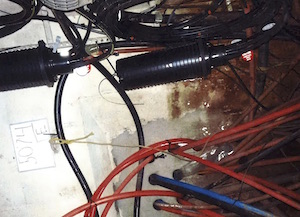
Splice case in AT&T manhole, click for the big picture.
Update: Webpass was just acquired by Google Fiber. That won’t have an immediate impact on the proceeding – lots of hoops to jump through first – but long term, it’ll be fun to watch. Stay tuned.
Telephone companies and other regulated utilities have to share conduit and pole access. They can charge each other a particular rate for it or, if usable space is lacking, require upgrades. But they can’t refuse access completely and it has to be granted on a non-discriminatory basis.
It is notoriously difficult to get access to AT&T conduit. Now, a complaint (technically, a request for arbitration) filed with the California Public Utilities Commission by Webpass, a competitive broadband provider, documents exactly how hard it is. Links to the full set of documents are below.
Webpass tried to get permission to run fiber optic cables through AT&T’s conduits and put splice cases and loops of coiled, slack cable in AT&T’s manholes. According to Webpass’ filing, AT&T just said no…
AT&T California rejected Webpass’ plans to install splice cases and coil loops. In addition, while the drawings show that many ducts are only partially-filled, AT&T California has stated to Webpass that a fiber optic cable override (i.e., installation of fiber optic cable in available space that is already partially occupied by an existing AT&T California cable) is never allowed except in entrance facilities owned by other parties or unless AT&T California’s cable is enclosed in an innerduct, which is rarely the case. This means that even though there may be ample space in multiple partially-used conduits, in most cases AT&T California refuses to allow Webpass to install fiber in those conduits. And, in cases where Webpass is allowed to override an existing AT&T Califomia innerduct containing a fiber optic cable, AT&T California requires Webpass to install two additional innerducts, one for Webpass’ use and one to be reserved for AT&T Califomia’s use.
What is more, AT&T always denies access to the last open conduit in any location, because AT&T California claims a right to reserve that conduit for AT&T Califomia’s exclusive future use. Such conduit might be for entrance to a new building to which AT&T California just installed service (for which a spare conduit would likely remain unneeded for many years) or it could be an open conduit between two manholes in the street. In either event, if it is the last open conduit, AT&T Califomia has been very clear that access will be denied 100% of the time.
AT&T California’s policies are blatantly discriminatory and anticompetitive. AT&T California installs its own splice cases in manholes, and Webpass is informed that AT&T California has permitted other communications providers to do so as well. Exhibit C is a photograph of splice cases in an AT&T California manhole. Webpass is also informed that AT&T California freely overrides its own cables and innerducts (as well as cables and innerducts owned by other companies) in partially vacant conduit, including where the existing cable in the conduit consists of copper pairs. Additionally AT&T Califomia does not go through the same roping and tagging process to reserye space that competitive providers are compelled to follow’ AT&T California just sends out crews to install cable in any available open space and documents the build upon completion.
AT&T’s initial response was to have the complaint dismissed as improper on technical grounds. The first hearing was scheduled for last Friday and by all appearances seems to have taken place, although I haven’t confirmed it. If the CPUC jumps into this dispute with both feet, it will be an important precedent for competitive broadband providers, no matter what it decides.
- Webpass request for arbitration of a conduit access dispute with AT&T, 26 May 2016
- Specific access to structures terms of Webpass’ agreement with AT&T, standard form as of 18 May 2012, submitted by Webpass
- General terms of Webpass’ conduit access agreement with AT&T, standard form as of 14 June 2012, submitted by AT&T
- Maps and drawings submitted by Webpass, with AT&T’s response, included in Webpass’ request for arbitration filed 26 May 2016
- Photo of splice case in AT&T manhole included in Webpass’ request for arbitration filed 26 May 2016
- AT&T’s motion to dismiss Webpass’ request for arbitration, 3 June 2016
- Webpass’ full filing, 26 May 2016 (11 MB)
